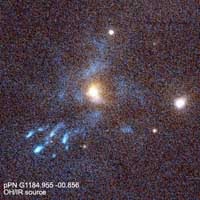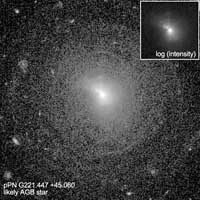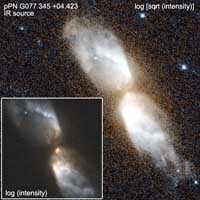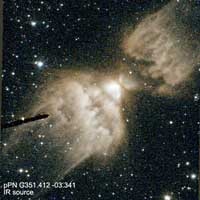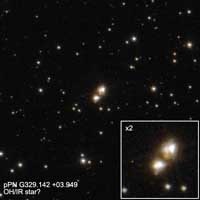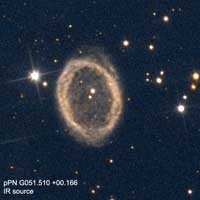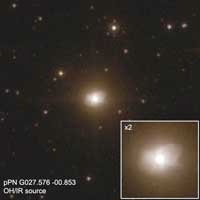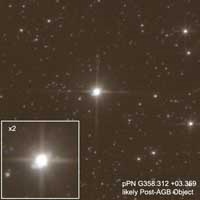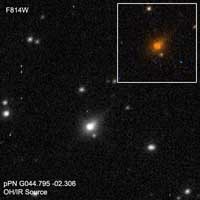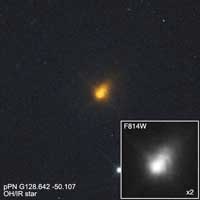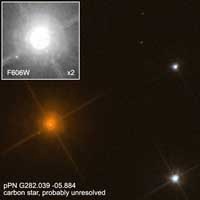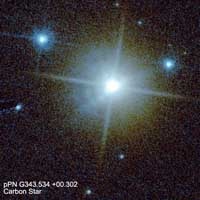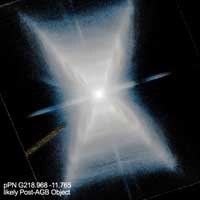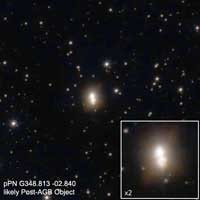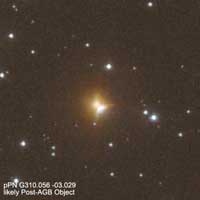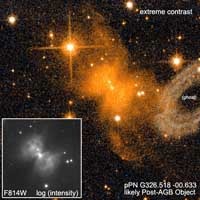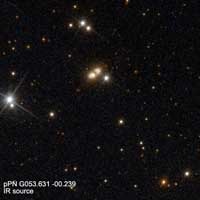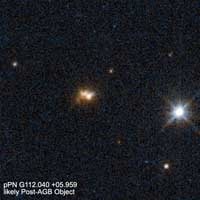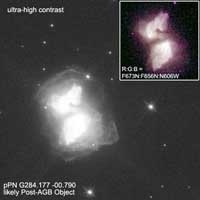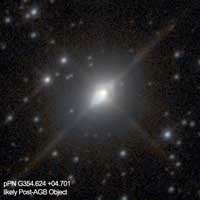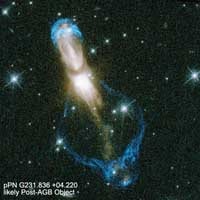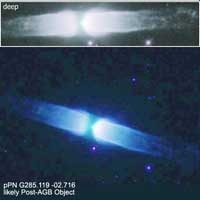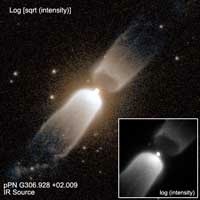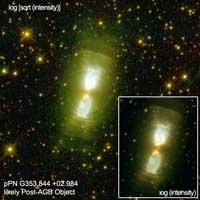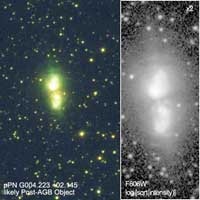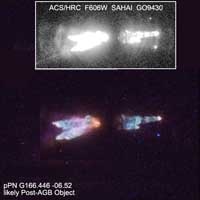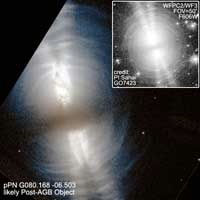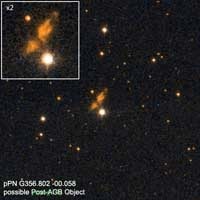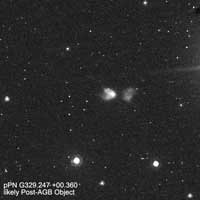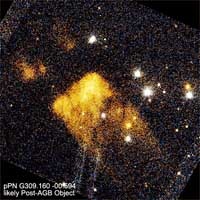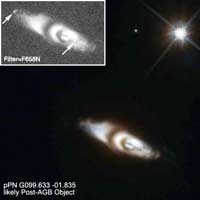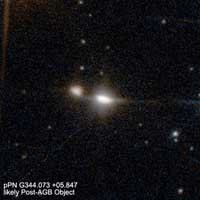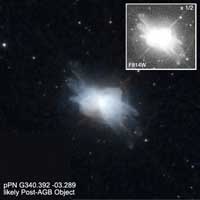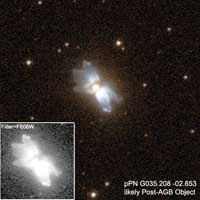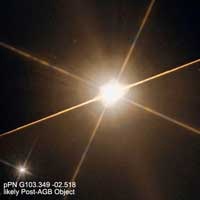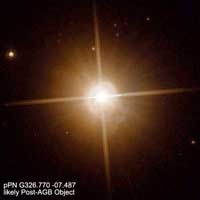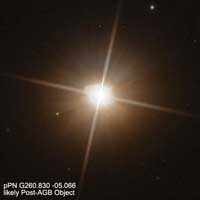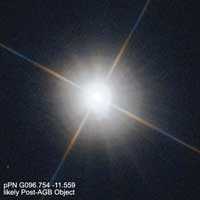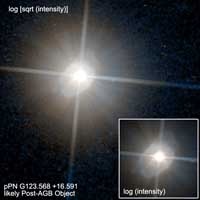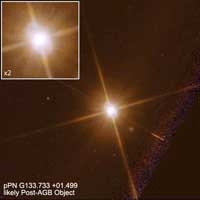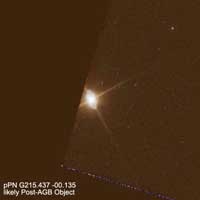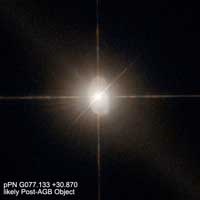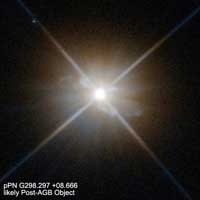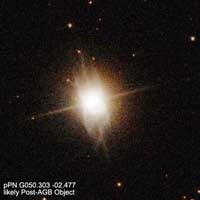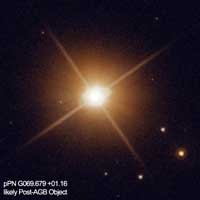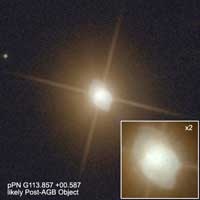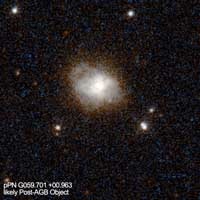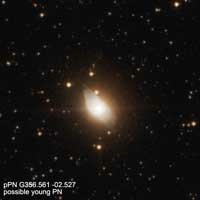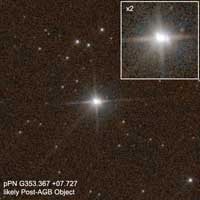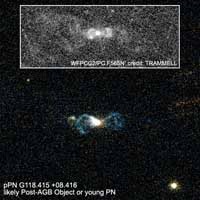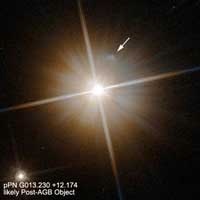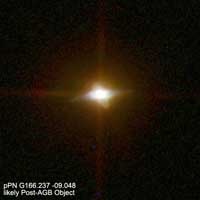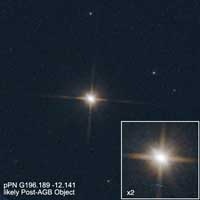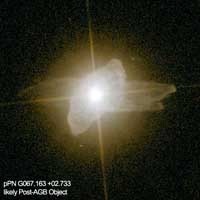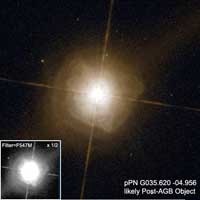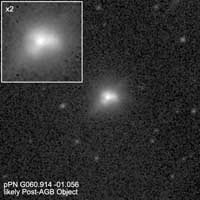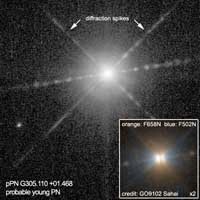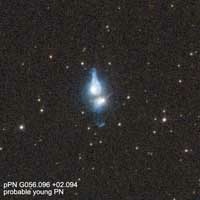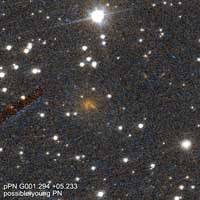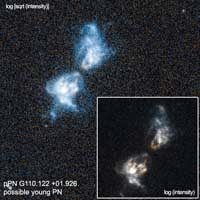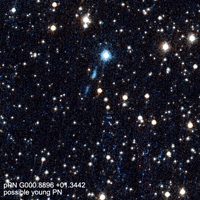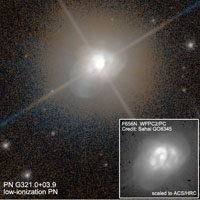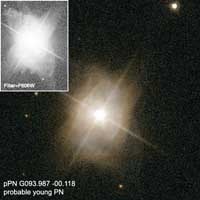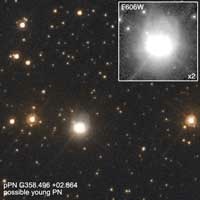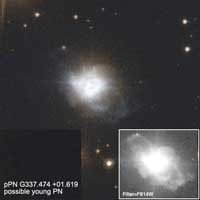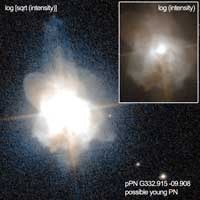The Catalog of Hubble Images of Nascent and Infantile Planetary Nebulae
aka pre-PNe
or proto-PNe
Bruce Balick, Joe Huehnerhoff, and Jennifer BaernyAstronomy Department, Universityof Washington
This web page is still a work in progress.
Please be sure to use the appropriate citation in progress
,
and please be sure to credit the original source of each
image.
|
IMAGE CONTENT
The images are identified by their galactic coordinates, continuing a nomenclate that has been adopted for PNe by Acker and extended to post-AGB objects in the RA and dec coordinates are in decimal degrees when they were available from the Torun Catalogue; o; otherwise the coordinates are in hours and degrees taken from SIMBAD. The field of view
( The HST images of pPNe were not obtained in any particularly uniform manner: cameras, filters, exposure times, and undoubtedly in some cases, inaccurate coordinates play roles that cannot be ascertained. Worse still, the target selection method varies enormously from one proposal to another. Some proposals select by optical color, others by infrared colors, some by OH masers, and some are selected for nothing more than their long record of study (e.g., the Red Rectangle). In short, the selection biases for this sample are many, and we cannot predict whether this group of pre- or young-PNe are typical in any way. We can only hope that there is safety in numbers. We wish to acknowledge the work of many people whose work made these images possible. Of particular note are Raghvendra Sahai, Margeter Meixner, Sun Kwok, Bruce Hrivnak, their many collaborators, other people who are not named here but whose images we have used, and of course the people who support the HST Archives(2) and the Hubble Legacy Archive(3). CLASSIFICAITIONS
The images are shown in three groups and two subgroups. The groups are: AGB nebulae, post-AGB-nebulae, and young planetary nebulae. The boundaries that separate these classes are not well defined.
Nebulae have been classified Each group is divided into two subgroups: those with evidence of a lane or disk of circumnuclear dust in optical images, and those without. Within each subgroup, pPNe with similar morphologies are grouped together in the images below. This determination is made by eye. Those objects for which a planar layer of dust lies near the plane of the sky, or for which the dust absorption and scattering opacities are small will obviously be misclassified. Roughly half of the sample is found in each subgroup. Further subcategorization by morphology is possible but limited by a variety of insidious problems, not the least of which are signal-to-noise ratio, complex wings on point spread functions, severe local extinction, and inadequate spatial resolution. The search for resolved structure is often hampered by the appearance of a bright star and its diffraction pattern. The point-spread function of the cameras on HST differ from one another. No attempt was made to measure and subtract the PSF to uncover structures. Instead, once the images were calibrated we carefully examined the logarithmic displays of the images and used our judgement to decide whether the image was sufficiently resilved to be included in this catalog. The most dubious cases are those of IRAS09425-6040, an extremely red carbon star (bright at 600nm but absent at 435nm) and IRAS17279-1119. |
SUMMARY OF RESULTS We find that the frequency of core dust lanes is lowest (about 1/3) in pre-AGB Objects compared to other classes (about 1/2), but the small sample size (15 objects of pre-AGB objects) renders that conclusion uncertain. Symmetry about one axis is common (58 of the entire sample of 80 objects). Symmetry about multiple axes is found in about 20% of the entire sample and varies with classification (i.e., evolutionary state): none of 15 pre-AGBs objects, 7 of 54 post-AGBs, and 4 of 11 young PNe have multiaxial symmetries. The increasing fraction of multiple symmetry axes is probably real; however, the numbers are small. Round pPNe are rare; however, such objects may be difficult to recover without a subtraction of the Airy rings of the PSF in many cases. Note that the single-axis symmetry is all but imposed by a dust lane unless, of course, multiple symmetry axes are readily distinguishable. The appearance of an optical image is the result of dust-scattered starlight unless the gas is ionized. In both cases the distribution of light is determined only in part by the spatial
distribution of gas or dust particles. Particularly in reflection nebulae the geometry we see is that of the subset of dust particles that are illuminated by starlight. The illumination pattern is
shaped by dust near the nucleus, and the flux of scattered light will generally decrease as r^-2. Dense knots can impose artificially strong finger-like ionization structures even when the gas is
otherwise fairly uniform in distribution. This effect is well known in mature PNe, and may help to explain the shapes of some Three additional image compilations appear at the end of the HST image catalogue. The first of these consists of ten objects that show evidence of rings or ring-segments (called The third compilation (at the very end of this page) is a comparison sample of low-ionization PNe, all taken from GO6353
(PI: Sahai). The purpose for this addendum is to provide a set of young PNe that are just emerging from the pPN evolution phase. Unfortunately there is no clear way to define One striking result is that none of the low-ionization (i.e. young) PNe exhibit evidence of dust lanes, which is a precipitous change from all other other classes of PNe presented here (IRAS 04333+3333 = PN K 3-66 may be an exception since it has obvious equatorial ionization shadows that imply that a dark disk is present. Another result is the relatively large fraction of young PNe that show elliptical morphologies. Perhaps this is simply the result of the sudden "pulse" of thermal pressure at the onset of ionization as the ionization front sweeps into the once-neutral gas and the shock that precedes it disrupts the complexity of the nebular geometry. We also notice that none of this sample has arcs, rings, or pinwheels, all of which are comparably rare in mature PNe. |
Click on the image thumbnail or its name for the large image and legend. Use your browsers "Find" tool to locate objects - IRAS names are used wherever possible. If you don't know the IRAS name then use SIMBAD to find it.
North is at the top of each image. Objects with similar morphologies are presented near one another in the table ofimages (from left to right).
Compilation I: HST Images of Extended Structures in the Cores (80 objects)
Compilation II: HST Images of Showing Rings and Arcs (10 objects)
Compilation III: HST Images of Pinwheels and Spirals (4 objects)
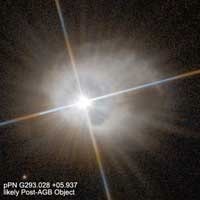 IRAS 11385-5517 [HD101584] |
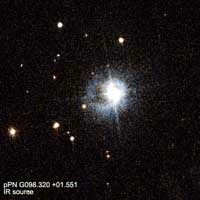 IRAS 21423+5458 [no alternate] |
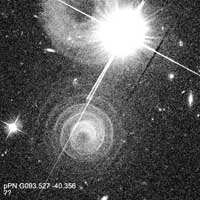 IRAS 23166+1655 [CRL 3068] |
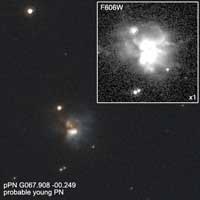 IRAS 20011+3024 [PN K 3-52, PK 067-00 1] |
Compilation IV: Comparison Sample: Young pPNe (19 objects from GO6353/Sahai)
With Dust Lanes (none) | ||||
Without Dust Lanes (morphology subclassificaions: 5 ellipticals, 8 bipolars, 3 multipolars, 2 complex, 1 unclassifiable) | ||||
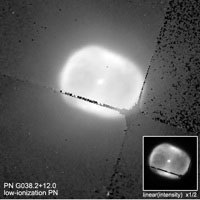 IRAS 18152+1007 [PN Cn 3-1] |
 IRAS F05251-1244 [IC 418] |
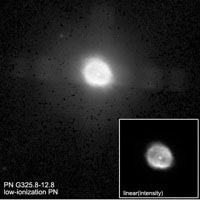 IRAS 16498-6409 [Hen 2-182, PN Sa 2-157] |
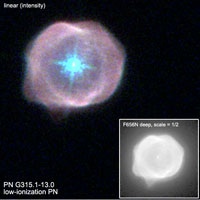 IRAS 15318-7144 [Hen 2-131, PN SaSt 2-9] |
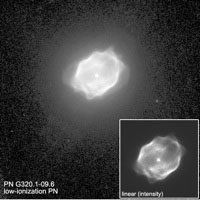 IRAS 15513-6600 [Hen 2-138, PN SaSt 2-10] |
 IRAS 04215+6000 [PN M 4-18] |
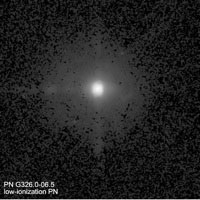 IRAS 16114-5946 [Hen 2-151] |
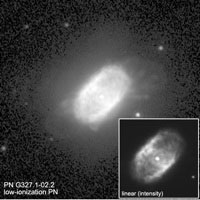 IRAS 15559-5546 [Hen 2-142, PN SaSt 2-11] |
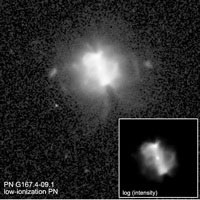 IRAS 04333+3333 [PN K 3-66] |
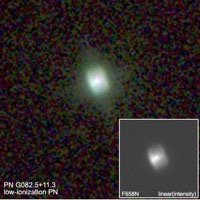 NGC 6833 [no alternate] |
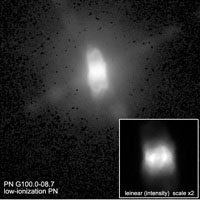 IRAS 22296+4732 [PN Me 2-2] |
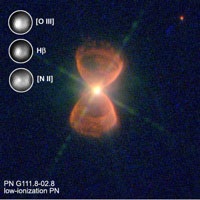 IRAS 23239+5754 [PN Hb 12] |
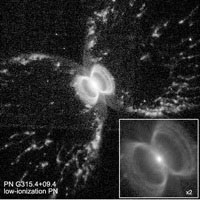 IRAS 14085-5112 [Hen 2-104, Southern Crab] |
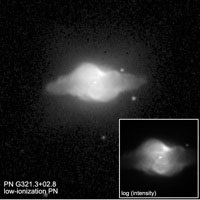 IRAS 15015-5459 [Hen 2-115, PN Sa 2-112] |
 IRAS 18022-2822 [Hen 2-339, PN M 1-37] |
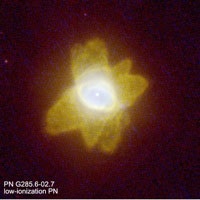 IRAS 10214-6017 [Hen 2-47, PN SaSt 2-5] |
 IRAS 11369-6835 [Hen 2-71, PN SaSt 2-7] |
 IRAS 17427-3010 [Hen 2-277, PN M 1-26] |
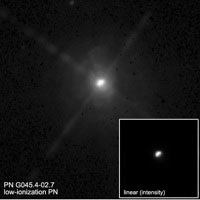 IRAS 19219+0947 [PN Vy 2-2, PN M 1-70] |
|
-----------
(1) Much of the data presented in this catalog were obtained from the Multimission Archive at the Space Telescope Science Institute (MAST). STScI is operated by the Association of Universities for Research in Astronomy, Inc., under NASA contract NAS5-26555. Support for MAST for non-HST data is provided by the NASA Office of Space Science via grant NAG5-7584 and by other grants and contracts.
(2) Many of the images presented in this catalog were obtained from the Hubble Legacy Archive, which is a collaboration between the Space Telescope Science Institute (STScI/NASA), the Space Telescope European Coordinating Facility (ST-ECF/ESA) and the Canadian Astronomy Data Centre (CADC/NRC/CSA).
(3) This research has made use of the SIMBAD database, operated at CDS, Strasbourg, France
(4)
AGB Nebulaeare extended regions associated with objects that are not listed as Post-AGB Objects in the Torunn Catalogue or SIMBAD and that surround stars with late-type spectra.
